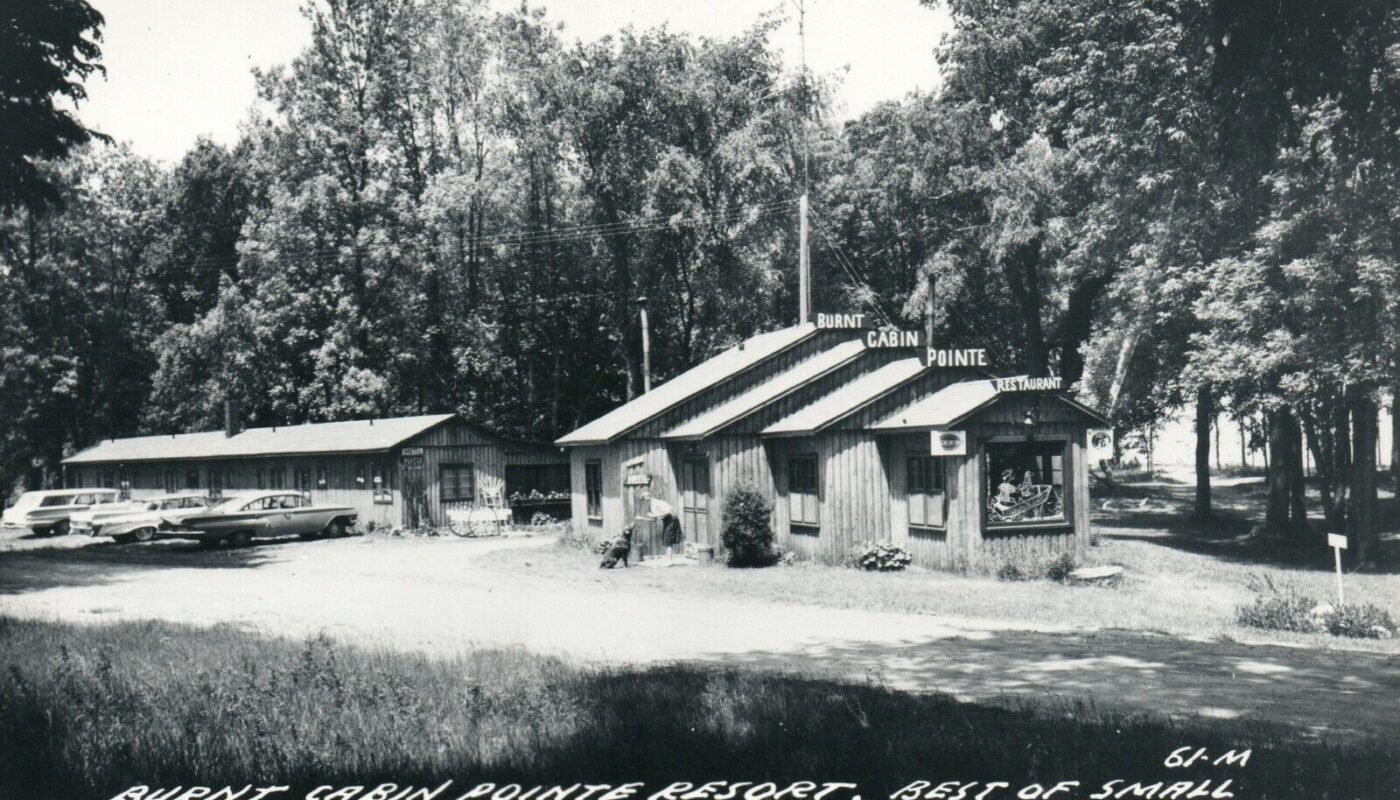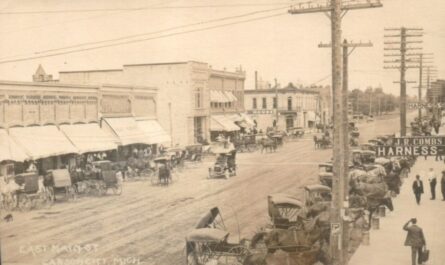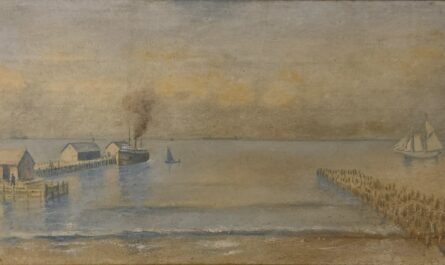We have dropped in to the Eagle Bay kayak launch many times while travelling to Grindstone City to have lunch at Shelly’s. Its a peaceful little beach with a small parking area. Most of the time its empty, which is strange because it would be a great launching point for kayakers when visiting Turnip Rock. Once out on the lake it would be a straight 2 mile paddle across Alaska Bay to visit the rock formation. This is a slighly shorter route then starting at Bird Creek County Park.
Burnt Cabin Point is an interesting name. However details on where this name came from and the history of this landmark are a bit scetchy and looks to have been lost with time. However with a little armchair history I did manage to find a bit more about this overlooked point of interest at the Tip of the Thumb.
Early Settlement at Burnt Cabin Point (1852)
Burnt Cabin Point’s story begins in the mid-19th century. The first pioneers arrived on this Lake Huron shoreline shortly after Michigan’s Thumb region opened to settlement. Henry Gill was among the earliest: he landed at Burnt Cabin Point on July 4, 1852. At that time the point was a remote outpost east of Port Austin, surrounded by dense forest and Lake Huron’s rocky shoals. Gill and other early settlers (like fisherman Jonathan Stockman at nearby Pointe aux Barques) scratched out livelihoods in the wilderness, fishing the abundant waters and hunting in the woods. The name “Burnt Cabin Point” likely arose from a long-forgotten cabin fire in the area’s pioneer days, a name that stuck as the point’s enduring identity.
Maritime Events and Shipwrecks (1870s–1900s)
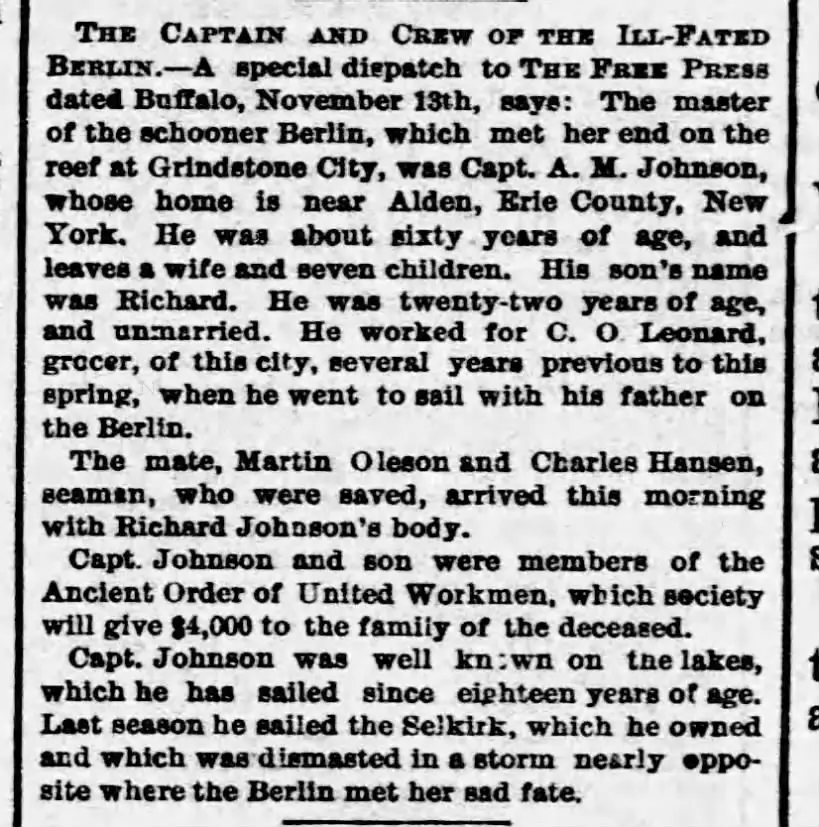
Burnt Cabin Point’s location near the tip of the Thumb made it a landmark for mariners – and the site of dramatic shipwrecks in the age of sail and steam. In November 1877, the three-masted schooner Berlin ran aground on Burnt Cabin Point Shoal during a ferocious gale. Captain A.M. Johnson, sailing through a dark, stormy night with a load of limestone, missed the Pointe aux Barques lighthouse and struck the rocky “fangs” off Burnt Cabin Point The Berlin broke apart in pounding waves; Captain Johnson and several crew were swept overboard and perished in the icy water. Local farmers telegraphed for help at daybreak, and a U.S. Life-Saving Service crew from Pointe aux Barques rushed over horse-trails with a surfboat. By the time they arrived, only two half-frozen crewmen clung to the wreck’s mast – they were rescued, but four of the schooner’s crew had died. The Berlin was torn to pieces by the storm and winter ice, leaving only scattered timbers that wash ashore even today.
Another calamity struck in 1904 with the loss of the Wyoming, a wooden steamship (originally a schooner barge). On November 12, 1904, the Wyoming caught fire during a gale and foundered about 8 miles east of Burnt Cabin Point. Fortunately, all crew members survived that disaster – they were rescued by the lifesaving station after abandoning ship. The charred hull of the Wyoming sank to the lakebed with its cargo of timber. These and other wrecks made the waters off Burnt Cabin Point part of Michigan’s maritime lore, underscoring the point’s rugged reputation among Great Lakes sailors. (Even today, scuba divers and historians identify remnants of the Berlin and Wyoming near Eagle Bay’s shallow reefs.)
Rise of Burnt Cabin Point Resort (1950s–1960s)
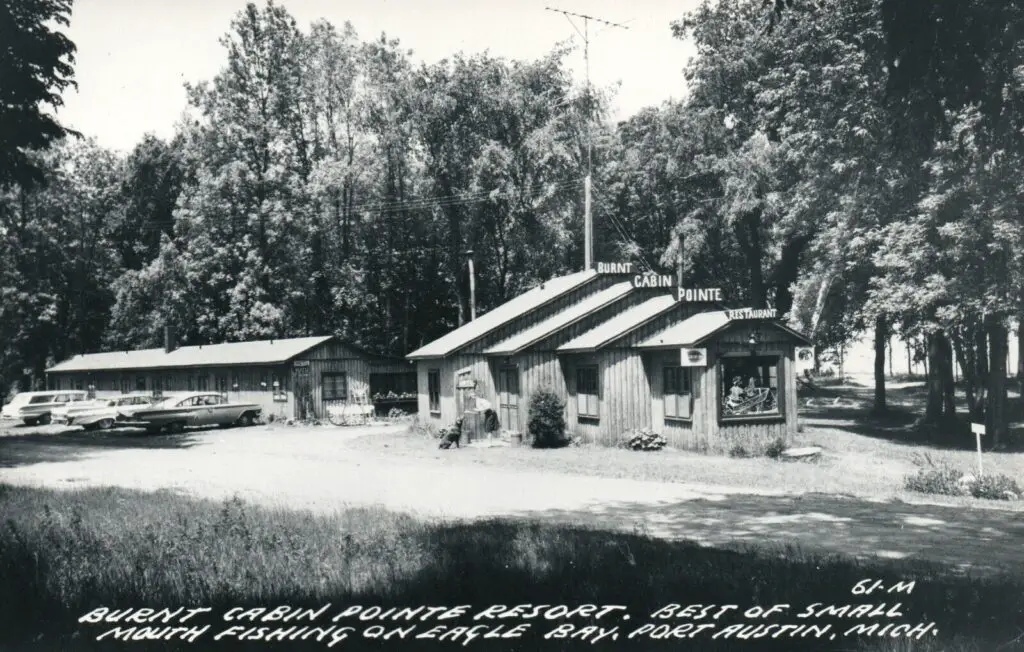
By the mid-20th century, Burnt Cabin Point’s wild shores found new life as a modest up-north resort. After World War II, Michigan’s Thumb saw growth in outdoor recreation, and the Eagle Bay area east of Port Austin attracted sport fishermen and vacationers. Sometime in the 1950s, a small resort was established at Burnt Cabin Point, taking its name from the point. Around 1960 it came under the ownership of Charles “Chuck” Mortimer, who became the resort’s most prominent proprietor. Mortimer’s Burnt Cabin Pointe Resort (spelled with an e on “Pointe”) embraced a rustic, backwoods style. It was not a grand hotel, but rather a cluster of simple lakeside cabins and a motel-style lodge tucked among the trees at the water’s edge. Burnt Cabin Pointe Resort in its heyday (1960s) offered lakeside lodging and a rustic restaurant on Eagle Bay, east of Port Austin. Mortimer lived on the property year-round and personally welcomed guests, earning a reputation for hospitality.
The resort’s unassuming facilities belied its unique charm. A low wooden lodge building housed a restaurant and office, marked by a hand-painted “Burnt Cabin Pointe Restaurant” sign over the door. Nearby, a row of basic motel units and cabins provided overnight accommodations for anglers and families. The grounds were informal – sandy driveways under tall oaks, a few picnic tables, and easy footpaths leading down to the shore. Visitors could pull right up in their 1950s station wagons (as seen in the photo) and settle in for a Thumb coast fishing getaway. During summer, Mortimer’s resort bustled with activity as boats were readied at the beach and the smell of breakfast from the little restaurant drifted through the woods.
Fishing, Beaches and the Resort’s Offerings

Burnt Cabin Point Resort became known especially for its smallmouth bass fishing. Eagle Bay’s rocky shallows were (and still are) prime habitat for feisty smallmouths, and the resort capitalized on this asset. Period advertisements touted the resort as “noted for bass fishing,” offering boats, bait, motel and restaurant accommodations to its guest. In fact, the resort sat adjacent to a public access launch site on Eagle Bay, making it a convenient base for fishermen. On opening day of bass season, anglers often caught their limit of smallmouths in these waters. A travel column in the late 1950s reported that one fisherman “limited out on smallmouth bass opening day” at Eagle Bay, and the writer “went up the second day and did the same” thanks to the hot fishing action near Chuck Mortimer’s resort. Besides fishing, guests enjoyed the sandy beach and surf on Lake Huron. The shoreline at Burnt Cabin Point features shallow, sandy-bottomed water ideal for wading and swimming on calm summer days. The resort provided rowboats and outboard rentals, and kept fishing bait on hand for guests. Its small restaurant served up breakfast, lunch, and fresh local catches for dinner – giving travelers a taste of Thumb country cuisine without needing to drive into town. All of this was offered in a peaceful setting “about 125 miles from Detroit,” as one ad noted, making it an accessible weekend retreat for city dwellers. The combination of good fishing, a pleasant beach, and homey meals made Burnt Cabin Point Resort a minor but fondly remembered part of the region’s outdoor recreation culture.
Fire and the Resort’s Disappearance (1960s)
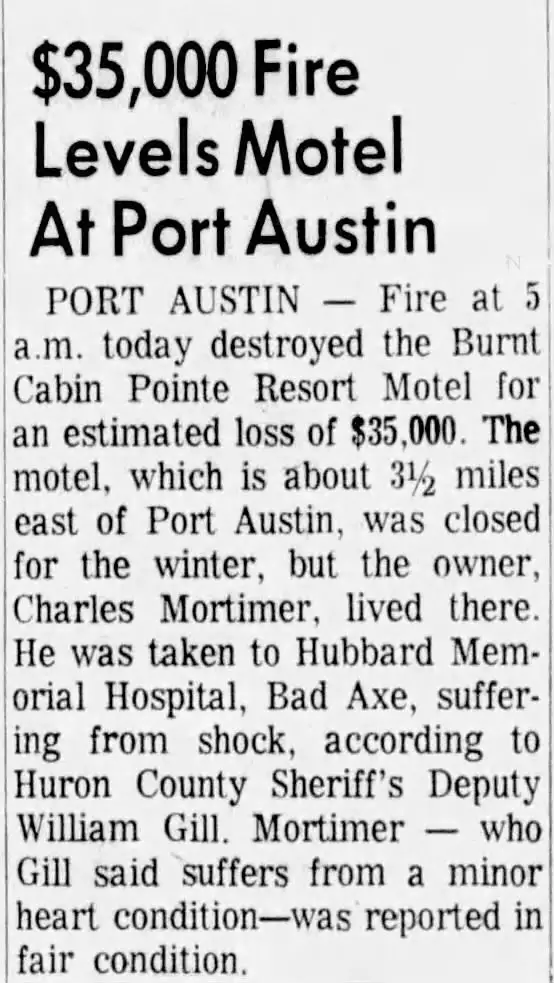
The prosperous years of Burnt Cabin Point Resort were relatively brief. In the early 1960s, the site even appeared as a labeled locale on Michigan state maps – a sign of its local significance. But tragedy struck on a cold winter morning in the mid-1960s: a fire broke out before dawn and destroyed the resort’s motel building. Fire crews responded around 5:00 a.m., but flames leveled the structure, causing an estimated $35,000 in damage. The motel had been closed for the off-season, but owner Charles Mortimer was sleeping in his quarters there and barely escaped. Suffering from shock (and a minor heart condition), Mortimer was rushed to Hubbard Hospital in Bad Axe; he survived and was listed in fair condition. The cause of the blaze was never determined. This devastating fire effectively ended the resort’s operation. With the main lodging gone and Mortimer’s health shaken, Burnt Cabin Point Resort did not reopen for the next season.
Thumb Landmark Removed From Official Maps 1963
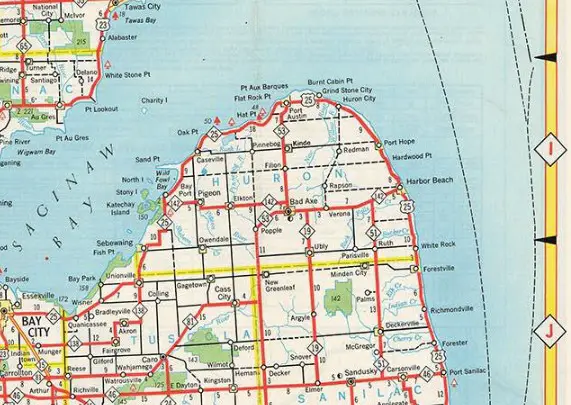
Around the same time, Burnt Cabin Point literally disappeared from official maps. In 1963 the Michigan State Highway Department modernized its highway map and removed many small unincorporated place names. Burnt Cabin Point – along with other little-known Huron County landmarks like Oak Point and Flat Rock – was “wiped off” the new state map as if it never existed. This bureaucratic change symbolized the resort’s fade from public view. By the late 1960s, Burnt Cabin Point was no longer advertised in travel guides, and the property quietly reverted to private use. Charles “Chuck” Mortimer, the erstwhile host, continued to reside on the site for some years, but the flow of vacationers and fishermen largely shifted to other nearby accommodations. The era of the rustic family-run resort at Burnt Cabin Point had come to a close.
Legacy, Lore and Conservation

Although the resort ceased operations, Burnt Cabin Point left an imprint on the region’s recreational lore. Longtime anglers and Thumb residents retained memories of the friendly little spot on Eagle Bay. Decades later, in the 1990s, Detroit Free Press columnist Bob Talbert – an icon of Michigan travel writing – reminisced about staying at the old Burnt Cabin Point property. Talbert’s nostalgic mentions of the place (long after its closure) showed that Burnt Cabin’s charm lingered in Michigan’s collective memory. He and others recalled the superb bass fishing, the simple pleasures of that beach, and even the quirky name that sparked curiosity. The site became something of a local legend: a vanished resort that embodied the “old Thumb” vibe of the mid-20th century.

Today, little remains of the resort’s structures, but Burnt Cabin Point itself is protected as part of a coastal wetland preserve. The surrounding Eagle Bay wetlands and wooded dune swales – approximately 243 acres in all – are recognized as part of the Michigan Upper Thumb Wetlands, an important habitat for waterfowl and wildlife. The Michigan Department of Natural Resources maintains a public access at Eagle Bay (just west of the point) for kayakers, anglers, and beachgoers, ensuring the public can still enjoy this shore. The point’s shoreline is now mostly quiet and natural, with tall trees, marsh grasses and the gentle hush of Lake Huron reclaiming the area where cabins once stood. Burnt Cabin Point’s legacy lives on through its contribution to local history and conservation.
Final Thoughts about Burnt Cabin Point
The stories of Henry Gill’s 1852 landing, the shipwrecks of the Berlin and Wyoming, and the convivial resort run by Chuck Mortimer have all become threads in the history of Michigan’s Thumb. What was once a frontier camp, then a fishing resort, is now part of a protected wild shoreline – a full circle for Burnt Cabin Point, where history and nature converge on the beautiful waters of Eagle Bay.
Sources:
Local recollections and environmental reports – status of Burnt Cabin Point in the Upper Thumb wetlands and preservation efforts.
Pioneer History of Huron County (Verna Purdy, 1948) – early settlement accounts
Great Lakes Shipwreck Files and local histories – details on Berlin (1877) and Wyoming (1904) shipwrecks
Wes Oleszewski, Great Lakes Shipwrecks and True Tales – narrative of the Berlin wreck at Burnt Cabin Point
Michigan tourism and news archives (1950s–1960s) – Burnt Cabin Point Resort advertisements and features
Jimmie Donahue, “In Michigan – You’re Never Far from Fun in the Outdoors,” Detroit Times (late 1950s) – column on Eagle Bay fishing near Mortimer’s resort.
Huron Daily Tribune (circa 1965) – news report “$35,000 Fire Levels Motel at Port Austin” (Burnt Cabin Pointe Resort fire)
Burnt Cabin Point Taken off Michigan Road Maps 1963 The Bay City Times Bay City, Michigan, Sun, May 12, 1963. Page 12

